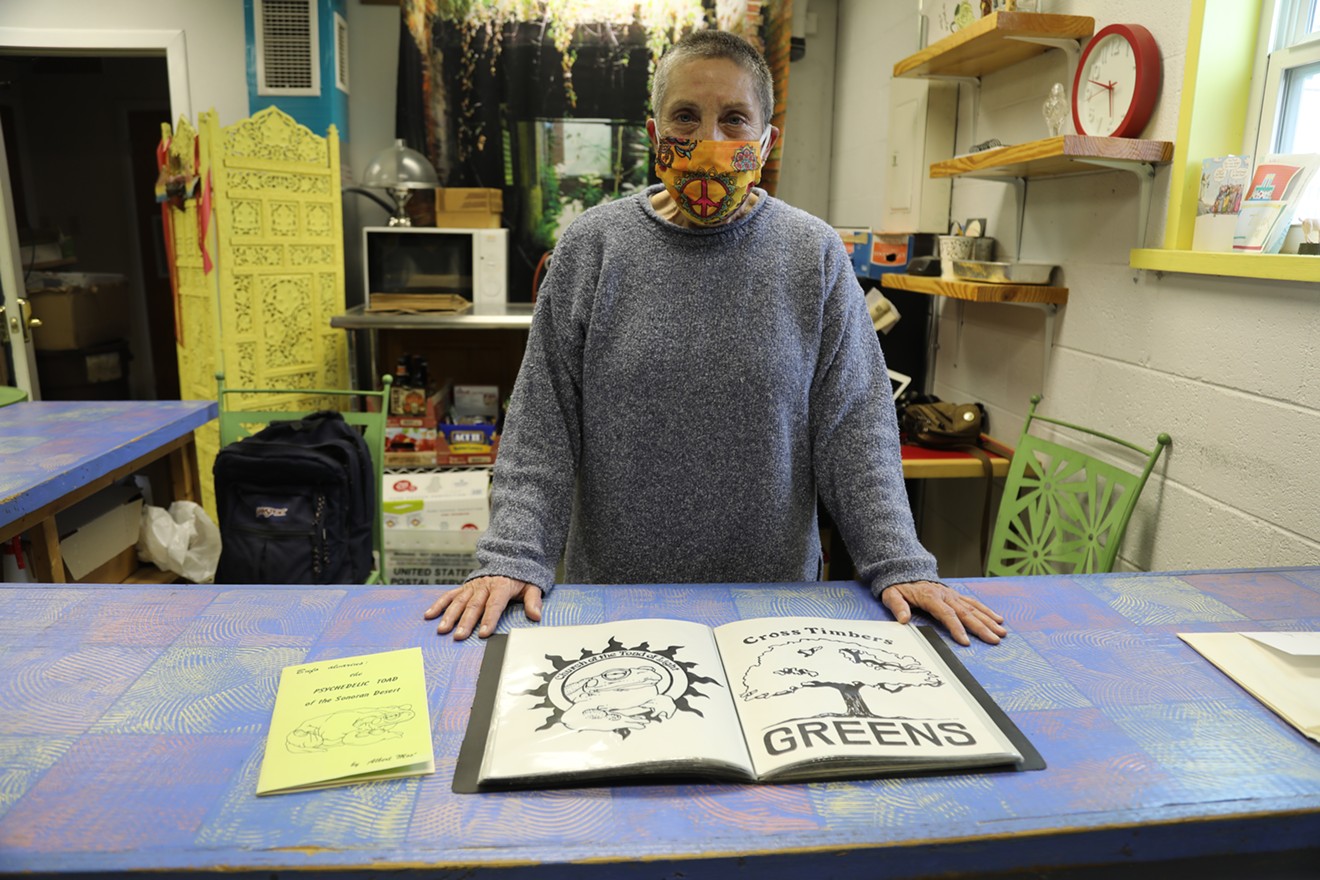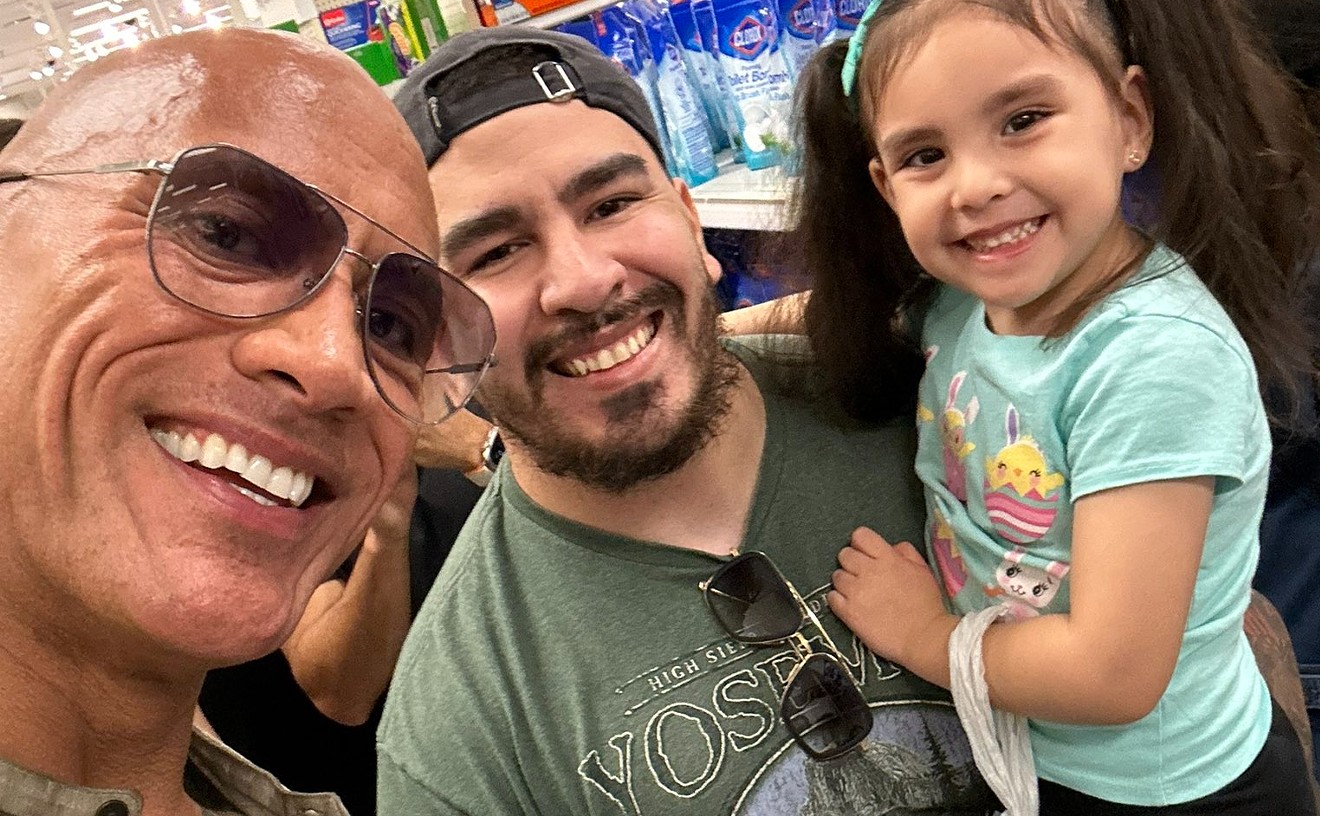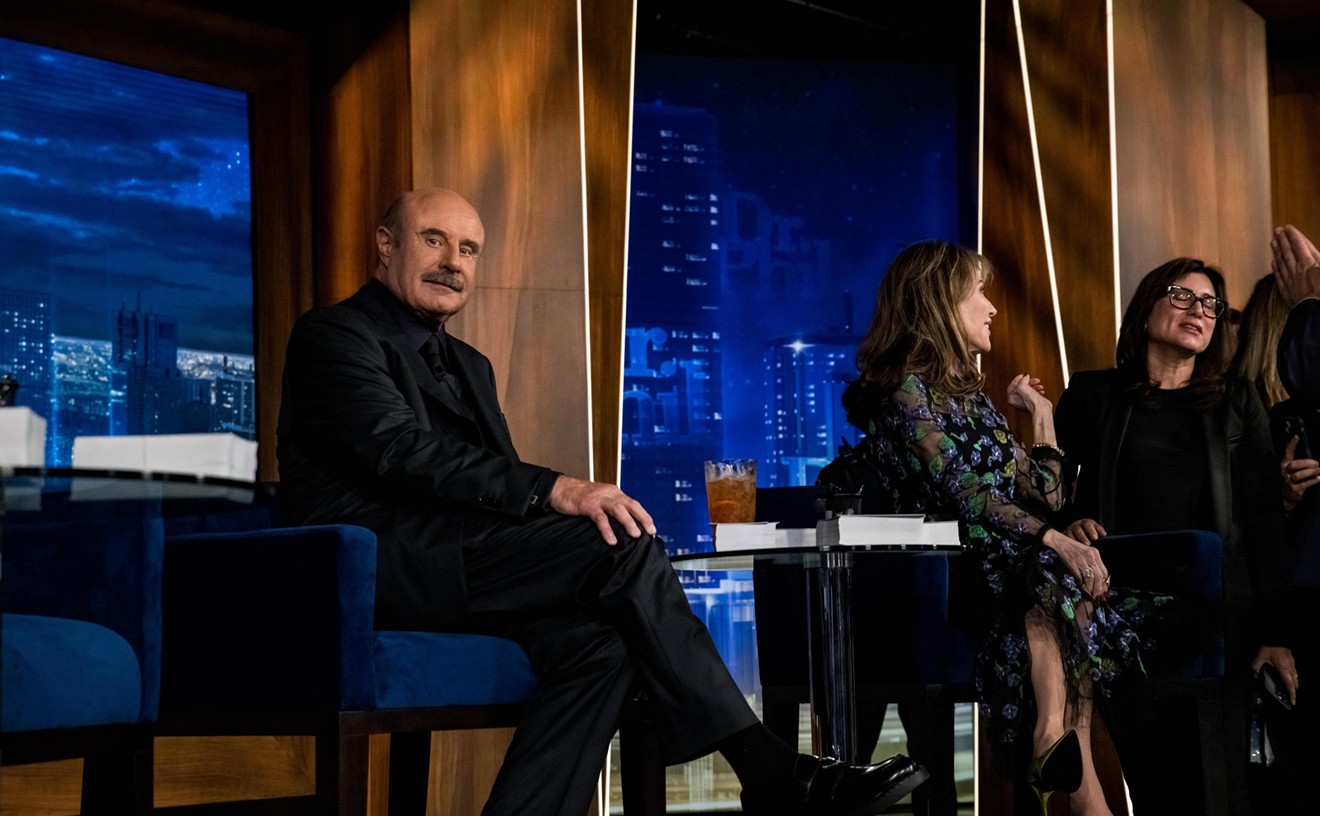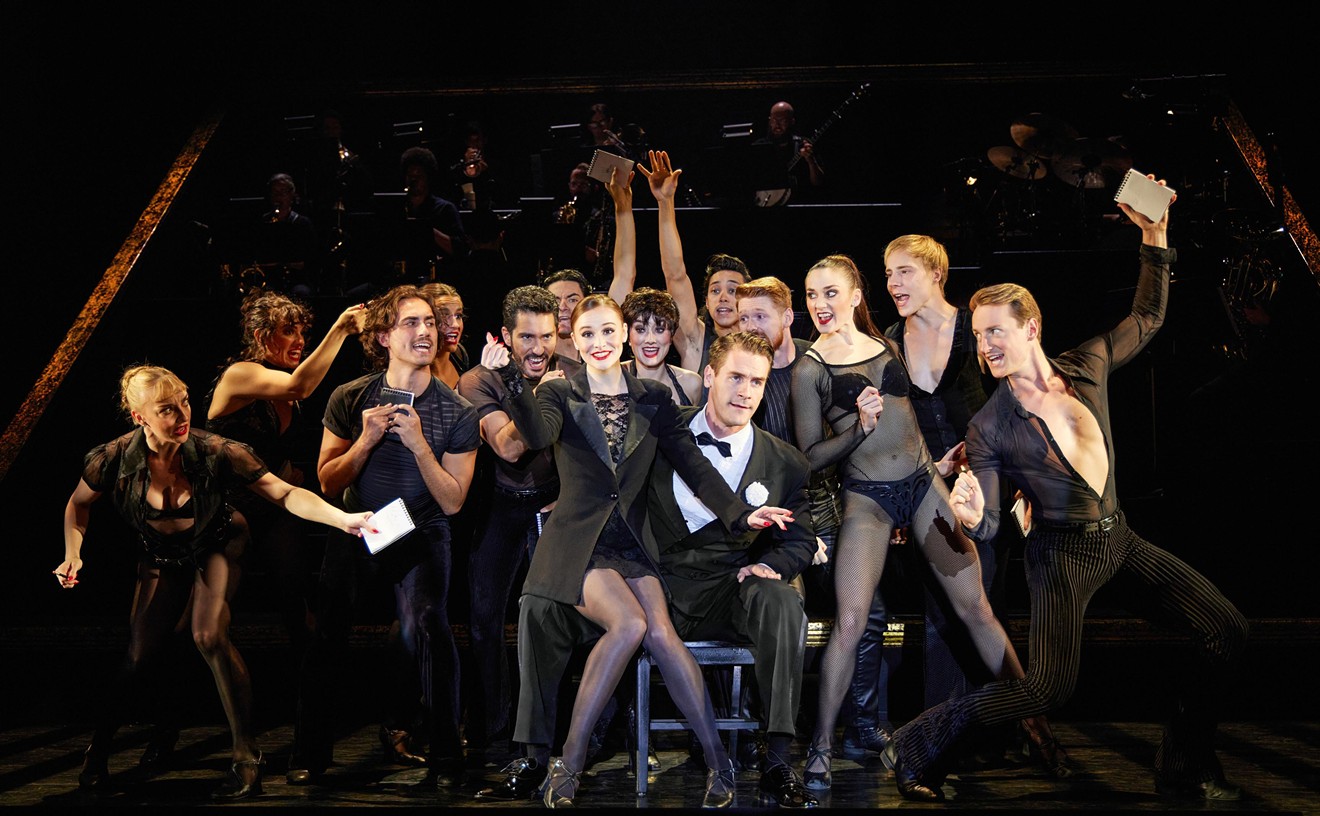An explanatory 1984 booklet printed at Venom Press in Denton first put the Sonoran Desert and its toad on the map; "Bufo Alvarius: the Psychedelic Toad of the Sonoran Desert," written by a reclusive Denton artist and researcher under the pseudonym Albert Most, is considered a groundbreaking collection of experiential, anecdotal testimony and academic research explaining everything anyone at the time would have needed to know to take a trip of their own. The author’s work, however, was wrongly credited to a man seemingly seeking his 15 minutes of unearned fame.
Journalist and documentarian Hamilton Morris recently helped the real author and the booklet’s artist Gail Patterson gain recognition for their work on the pioneering pamphlet, leading to reprintings of a new edition raising nearly $205,000 for The Michael J. Fox Foundation for Parkinson's Research and new T-shirt pre-sales that raised thousands of dollars for the Tucson Herpetological Society as well as for Patterson.
The first episode of Season 3 of Vice’s drug docuseries Hamilton's Pharmacopeia, “Synthetic Toad Venom Machine,” begins with Morris seeking to atone for the grave journalistic sin of misidentifying a source, allowing an impostor to claim to be the real author behind the Albert Most pseudonym in 2017’s Season 2 premiere episode, "The Psychedelic Toad." Until the new episode premiered in December 2020 clearing up the 2017 inaccuracy, only a handful of Dentonites knew the true location of Venom Press or the real identity of Albert Most.
Almost immediately after the 2017 episode aired, Morris received messages telling him he’d made a serious mistake, and, soon, he received a letter in the mail from a man claiming to be the real Albert Most.
The Fog of Reporting a Mystery
“I had become obsessed with finding the author of this pamphlet,” Morris says by phone.
The son of famed documentary filmmaker Errol Morris (The Thin Blue Line, The B-Side and The Fog of War), Hamilton Morris first started writing for Vice under a pseudonym. According to a 2015 profile in The New York Times, “his first article for Vice was a roundup of emerging psychoactive drugs, which he wrote under a pseudonym, D.H. Ticklish.”
Hamilton’s Pharmacopeia is a video version of a monthly print column that once ran Vice magazine.
In 2017, Morris set out to solve what he describes as “one of the greatest mysteries in ethno-herpetological history,” which was centered on Bufo alvarius, the only species of toad known to produce 5-methoxy-N,N-dimethyltryptamine (5-MeO-DMT), which Morris describes as “now one of the most coveted psychedelics, internationally.”
5-MeO-DMT is a highly psychedelic substance found in a wide variety of plants and in toxic secretions from the skin and the parotoid glands of the Bufo alvarius toad.
Taken orally, the “venom” proves toxic. Veterinary experts seem to agree the Sonoran Desert toad is one of the two most common culprits in poisoning incidents in dogs. Those who smoke the venom report that rather than producing a 6- or 8-hour marathon trip like many psychedelics, it instead offers a fast-as-a-rabbit journey beginning seconds after inhaling the vapors released by heating the dried exudate.
The Toad in the Desert
After nine months in the ground, the Sonoran Desert toad, sometimes referred to as the Colorado River toad, emerges from the ground ready to mate and filled with toxins to ward off enemies. As Morris described it on TV, “The growing demand has inspired roving bands of toad milkers to scour the Sonoran Desert in search of a venom more valuable than gold.”
The toad’s venom is milked or expressed and can be smoked after it's dried. In the 1984 pamphlet, Albert Most described the experience, just before giving instructions on how to milk the toads without harming them: “Within thirty seconds, there will be an onset of almost overwhelming psychedelic effects. You will be completely absorbed in a complex chemical event characterized by an overload of thoughts and perception, brief collapse of the ego, and loss of the space-time continuum.”
Whether extracted from toads or from South American plants or synthesized in a lab in Mexico as Hamilton demonstrates in the “Synthetic Toad Venom Machine” episode, 5-MeO-DMT is a potent hallucinogen, proving psychoactive in doses of 3 to 5 milligrams. When the author wrote the pamphlet, 5-MeO-DMT was relatively unknown and not yet a controlled substance. The Drug Enforcement Administration didn’t declare 5-MeO-DMT a Schedule I controlled substance until January 2011.
Ken in Denton
After the 2017 episode aired, Morris received a letter in the mail from Denton.
As read on camera in the 2020 episode, Kenneth Nelson wrote: “Hey, Hamilton, I heard you were looking for Albert Most. Perhaps I can help you fill in the missing pieces of your puzzle. I am Albert Most. I wrote about the toad. I smoked the toad venom. I’m Albert Most. Let’s talk sometime. Ken, Denton, Texas.”
Nelson was identified as an artist, environmentalist, independent researcher, and, for many in Denton, just “that guy who owns the old missile base.” (He owned part of the decommissioned Nike missile base just north of the college town.)
While in the military stationed in Georgia, Nelson read a magazine article in the August 1981 Omni summarizing an archeologist’s work on an excavation dig that unearthed 10,000 toad bones. Nelson was fascinated by the possibility of a psychedelic toad and began researching potential candidates.
The preface to the new, authorized edition of the pamphlet explains: “In the Department of Life Sciences at the University of North Texas [Nelson] encountered the work of Italian toxicologist Dr. Vittorio Erspamer, whose comprehensive chemical analysis of toad venoms showed that among the 40 species he analyzed from the genus Bufo, a single one, Bufo alvarius (syn. Incilius alvarius), was capable of biosynthesizing 5-MeO-DMT.”
Nelson’s first trek to Arizona proved toadless, as the toads estivate beneath the topsoil until the monsoon season. On the second road trip, Nelson gassed up his white Chevy sport van with his then-girlfriend Pat and a collie named Quanah and drove to the Sonoran Desert after the start of the rainy season in 1983.
Quanah spotted the first toad. Nelson sprung into action, grabbing the toad before “milking” the glands on the neck and limbs, spattering the toad’s venom on the van’s windshield. When the “viscous milky-white” venom dried, Nelson smoked it.
Once back in Denton, a technical writing course at UNT helped him on the way to publishing the pamphlet. Soon, mail order T-shirts were also available, by check or money orders sent to a Denton PO Box, for the cover design as well as The Church of The Toad of Light design.
Nelson never published his intended sequel, "The Handbook for the Serious Toad Collector," which was listed as recommended reading in the original booklet. As explained in a brief interview on the episode, Nelson included a passage from Aesop’s Fable “The Goose that Laid the Golden Eggs” as a type of cautious warning.
Once the episode picks up with Hamilton meeting Nelson in Denton, the viewer is given a peek at Nelson’s notes, which were stored in a footlocker and later placed in a series of binders. His files contained hundreds of pages of “unrealized projects,” and as the episode shows, even plans for a “synthetic toad venom machine,” including diagrams for a batch reactor. Nelson was clearly interested in creating a “biosynthetic pathway” to create the venom to isolate the 5-MeO-DMT.
The World Bufo Alvaruis Congress invited Morris to give a talk at its July 2019 convention for toad venom enthusiasts in Mexico City, and he saw it as a chance to expand on Nelson’s research. The annual event launched in 2018, hosts “scientists, practitioners, (neo) shamans, academics, writers, filmmakers, psychonauts, natives, doctors, and people from all over the world that have experienced the healing of the Bufo Alvarius / 5-MeO-DMT medicine, or are interested in learning more,” according to wbfa.info.

The original booklet "Bufo Alvarius: the Psychedelic Toad of the Sonoran Desert" from 1984.
Daniel Rodrigue
Sellers says he helped Ken assemble a bevy of proofs to present to Morris: five copies of both authorized printings of the pamphlet, photographic evidence, letters from readers and 5-MeO-DMT matchbooks with Patterson's toad illustration.
Before his health declined due to Parkinson’s disease, Nelson lived on the missile base for more than two decades. After breaking his hip in a fall, he moved into a care facility, never fully recovering nor returning to the base.
Kenneth Edward Nelson died October 8, 2019, a year before he was revealed to the world as the real Albert Most. No obituary for Kenneth E. Nelson appears online, but while many of his friends’ memories may have grown fuzzy over time, he and his gatherings at the base are remembered fondly by many in Denton. And, in some cases, by bands as far away as Norway.
Denton musician, DJ and artist Rob Buttrum knew Nelson for nearly 15 years, helping weld his art as Nelson’s health declined. Having booked concerts for more than a decade, Buttrum says he’d occasionally take bands out to “meet Ken and check out the base.” Buttrum and bandmates even recorded an album at the missile base.
“I remember thinking he always looked young for his age before those last three or four years,” Buttrum says.
When the final episode aired, he says, “I was relieved to see how good Ken looked.”
In Denton and beyond, thanks to interest by Al Roker, host of the now-defunct Food Network show Roker on the Road, Patterson and husband Ricky are known for their Spanked Balls, smoked meats and their award-winning spicy dry rubs at Big Fatty’s Spanking Shack.
Unlike the impostor in the 2017 episode, Patterson, who has an impressive portfolio packed with her detailed illustrations, possesses many of the original Bufo illustrations, a massive poster and other corroborating evidence to prove the pamphlet’s provenance.
The Pattersons' “shack” is even in the backside of the building that once housed Penny Press, aka Venom Press, where Nelson printed his series of pamphlets.
In the mid-’80s, Nelson provided Patterson with photographs of the toads upon which she based her illustrations. In one episode, Patterson shows Hamilton a photo on which one of the illustrations in the pamphlet is based.
In the follow-up episode, Morris seeks Nelson's and Patterson’s permission to reprint the pamphlet. “I also had no idea what the demand might be,” Morris says, expressing shock at the interest. “I thought 500 copies, that might be a lot. Worst case scenario, I'll have a couple hundred left, and I can give them away to friends. … And then they sold out in an hour.” The second printing of 2,500 copies sold out in “a day or so,” and a third pressing of 5,000 copies sold out in March.
Since being identified as the artist behind the iconic illustrations, Patterson says she has already had one person bring by a copy to be autographed.
“Who would want an autographed copy?” she says of her first reaction.
Now, she says, “I think it’s really flattering, and I just think Hamilton’s like unbelievably, you know, I’m just thankful he’s such a nice guy. He didn’t have to do any of this. And I think Ken’s laughing right now about all of this.”
An Amazon search for keywords in The Church of the Toad of Light reveals pages of merchandise emblazoned with Patterson’s Bufo illustrations on stickers, flags, coffee mugs, face masks, pet vests and remarkably cheap metallic signs. Sellers claiming to be “authentic” offer men’s and women’s T-shirts, sweatshirts, tank tops and baseball tees. But Patterson says the only “official” shirts being printed now are, thanks to Morris, the ones being offered at psychedelictoadofthesonorandesert.com.
“She really does deserve the credit because her illustrations are iconic and have been endlessly copied." Morris says. "There truly are people right now — even with the explicit reprinting of the shirts and the donation of all the profits to Gail — there’s still people ripping it off on Etsy and on Amazon.”
“I’m going to turn my little store into a ‘Bufo Boutique,’” Patterson says of Big Fatty’s storefront. “And then we can sell the T-shirts out of it, and anything else.”
While Patterson doesn’t own the 1984 copyright for the text of the book, she does for all her illustrations. So, T-shirts seem like the easiest Bufo merchandise that she could partner with a local business to produce a limited run.
Patterson recently teamed up with Denton’s Norman Roscoe for a couple of printed-in-Denton options of Church of The Toad of Light T-shirts.
There’s even talk of eventually reprinting the book in Denton, because, Patterson says, it would be cool to sell the booklets “in the little store where Penny Press was.”











